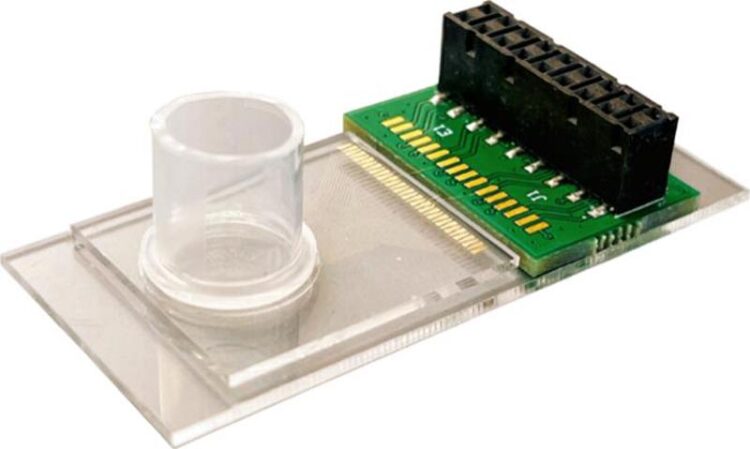Bioengineering breakthrough increases DNA detection sensitivity by 100 times

This is the device that detects DNA with a 100-fold greater sensitivity than traditional methods using an alternating electrical current.
Credit: Xiaoyu Zhang, Xiao Fan, Huilu Bao, and Jinglei Ping
University of Massachusetts Amherst researchers discover letting small amounts of DNA ‘dance’ can speed disease detection.
UMass Amherst researchers have pushed forward the boundaries of biomedical engineering one hundredfold with a new method for DNA detection with unprecedented sensitivity.
“DNA detection is in the center of bioengineering,” says Jinglei Ping, lead author of the paper that appeared in Proceedings of the National Academy of Sciences. Ping is an assistant professor of mechanical and industrial engineering, an adjunct assistant professor in biomedical engineering and affiliated with the Center for Personalized Health Monitoring of the Institute for Applied Life Sciences. “Everyone wants to detect the DNA at a low concentration with a high sensitivity. And we just developed this method to improve the sensitivity by about 100 times with no cost.”
With traditional detection methods, he says, “The challenge is basically finding the needle in a haystack.” There are lots of molecules present in a sample that aren’t the target DNA that can interfere with the result.
That’s where this method is different. The test sample is put within an alternating electric field. Then, “We let the DNA dance,” he says. “When the strands of DNA dance, they have a specific oscillation frequency.” Researchers can then read samples to see if there is a molecule moving in a way that matches the movement of the target DNA and easily distinguish it from different movement patterns. This even works when there is a very low concentration of the target DNA.
This new method has huge implications for speeding up disease detection. First, because it is so sensitive, diagnoses can happen at earlier stages of a disease progression, which can greatly impact health outcomes.
Also, this method takes minutes, not days, weeks or months, because it’s all electric. “This makes it suitable for point of care,” he says. “Usually, we provide samples to a lab and they can provide the results quickly or slowly, depending on how fast they go, and it can take 24 hours or longer.” For instance, he cites how with a diagnosis, a biopsy sample is frozen and then sent to a lab for processing, which can take up to two months. The near-instant results with this new method mean treatment does not have to wait for lab processing times.
Another benefit: it’s portable. Ping describes the device to be similar in size to a blood sugar test tool, which opens the doors to improvements in health on a global scale. “It can be used at places where resources are limited. I went to a country and the doctor usually goes to a village once or twice a year, and now, maybe they can have a base that has this kind of tool and they’ll have the chance to test for it quickly and easily.”
Ping is excited about the breadth of possible applications for this discovery, saying, “The nano-mechanoelectrical approach can be also integrated with other bioengineering technologies, like CRISPR, to elucidate nucleic acid signaling pathways, comprehend disease mechanisms, identify novel drug targets and create personalized treatment strategies, including microRNA-targeted therapies.”
Xiaoyu Zhang, a graduate research assistant from Ping Lab, will deliver an oral presentation relevant to this study at the Biomedical Engineering Society annual meeting on October 13, 2023 in Seattle, WA.
This research was supported by the Trailblazer Award Ping received from the National Institute of Biomedical Imaging and Bioengineering.
Contact:
Jinglei Ping: jingleiping@umass.edu
Julia Westbrook: jwestbrook@umass.edu 413-545-0149
Journal: Proceedings of the National Academy of Sciences
DOI: 10.1073/pnas.2306130120
Method of Research: Experimental study
Subject of Research: Cells
Article Title: Nanomechanoelectrical approach to highly sensitive and specific label-free DNA detection
Article Publication Date: 11-Jul-2023
COI Statement: The authors declare no competing interest.
Media Contact
Julia Westbrook
University of Massachusetts Amherst
jwestbrook@umass.edu
All latest news from the category: Medical Engineering
The development of medical equipment, products and technical procedures is characterized by high research and development costs in a variety of fields related to the study of human medicine.
innovations-report provides informative and stimulating reports and articles on topics ranging from imaging processes, cell and tissue techniques, optical techniques, implants, orthopedic aids, clinical and medical office equipment, dialysis systems and x-ray/radiation monitoring devices to endoscopy, ultrasound, surgical techniques, and dental materials.
Newest articles

Silicon Carbide Innovation Alliance to drive industrial-scale semiconductor work
Known for its ability to withstand extreme environments and high voltages, silicon carbide (SiC) is a semiconducting material made up of silicon and carbon atoms arranged into crystals that is…

New SPECT/CT technique shows impressive biomarker identification
…offers increased access for prostate cancer patients. A novel SPECT/CT acquisition method can accurately detect radiopharmaceutical biodistribution in a convenient manner for prostate cancer patients, opening the door for more…

How 3D printers can give robots a soft touch
Soft skin coverings and touch sensors have emerged as a promising feature for robots that are both safer and more intuitive for human interaction, but they are expensive and difficult…





















